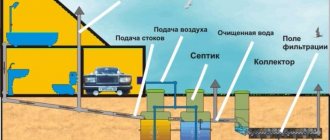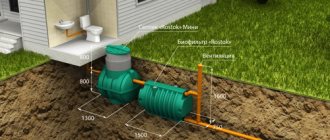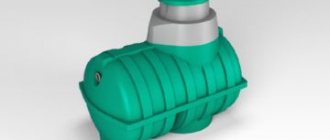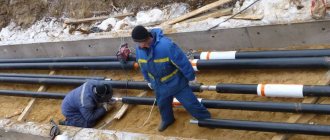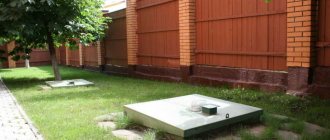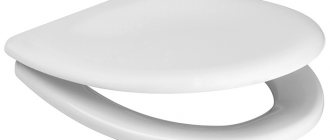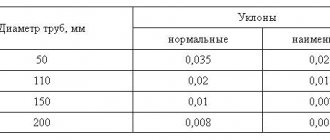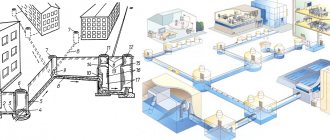Sewerage is a very important communications system in any modern residential or non-residential premises. Therefore, it is useful to have an idea of what types of sewerage exist and what types of sewerage are used in different premises.
Today the following classification of sewerage systems is used:
- Industrial sewerage , the main purpose of which is the treatment of industrial wastewater;
- Domestic sewerage , which can serve either an entire settlement (centralized) or a separate building or group of buildings (local);
- Stormwater, which serves to remove water accumulated as a result of rain from streets and roofs of houses.
Regardless of the type of sewerage, a distinction is also made between external and internal sewerage:
- External sewerage is located outside the premises and includes pumping stations, pipelines and treatment facilities.
- Internal sewerage is located inside a building or structure and consists of pipelines and household and plumbing fixtures connected to them.
In turn, external sewerage can be divided into three types:
- All-alloy sewer system, in which all types of wastewater (domestic, storm and utility) are transported together;
- Separate , in which the transportation of household wastewater is carried out separately from storm water;
- A semi-separate sewer system in which wastewater is transported separately to a common sewer where it is eventually combined.
Classification of sewerage systems
There are the following types of sewage systems for a country house:
- Industrial
. Used for cleaning and recycling production waste. - Storm (rain)
. It is used to drain water that falls to the ground in the form of precipitation. - Household
. Necessary for drainage of wastewater from residential and administrative buildings. This type of sewerage has two subtypes:— local: serves one house or several buildings; — centralized: covers a populated area.
In addition to classification by purpose, sewer systems are also divided according to their location:
- Internal
. Includes all plumbing and piping installed in the building. - Outdoor
_ Provides drainage of wastewater from buildings, for which pipelines, pumping stations, treatment plants and other devices are used.
External sewerage, in turn, can also be divided into separate types:
- alloy, ensuring the movement of all types of wastewater in one stream;
- separate, allowing for the movement of different types of wastewater through separate channels;
- semi-separate, in which wastewater is initially transported separately, but is processed in one collector.
Classification by purpose
Household sewerage is the disposal of products of human activity.
There are three classes of sewer systems:
- K1 - Household (household and fecal) services. Removal of contaminants associated with human activity. Domestic sewerage can be local, that is, equipped in a specific building, or centralized, citywide.
- K2 - Storm water. Removing water from the surface resulting from rain and snow. This also includes drainage sewerage, which is necessary to remove excess subsurface moisture.
- K3 - Industrial (production). Collection and cleaning of wastewater in industrial complexes, catering plants, medical and pharmaceutical institutions.
The main function of a storm drain is to collect and drain rainwater to protect the foundations, walls and roofs of houses, and asphalt surfaces. Flows are directed through highways to a storage tank, and then discharged into reservoirs or onto the soil, since they are not hazardous to the environment. In private households they water gardens.
Drainage-type sewers are installed where subsoil sources are located high to the surface and threaten to cause waterlogging of the soil. Special perforated drains are deepened into the soil to absorb moisture. It is then transported to drainage pits, ditches or well devices.
Storm sewerage - disposal of sediment and melt water
When creating a household network, it is taken into account that the outlet lines from the plumbing fixtures are equipped with water seals to prevent air from penetrating outside. These pipes are connected to risers through which the waste flows into the central network or treatment device. Risers are usually made of pipes with a cross-section of 100 mm, connections to plumbing fixtures - 50 mm.
When two or three types are combined in one complex, the system is called integrated. In residential and public buildings, domestic and storm sewerage systems are usually provided. Enterprises use sewers of all types - K1, K2 and K3, but with separate drains. Do not mix liquids with different composition, temperature, or aggressiveness.
Cable ducting is considered separately. It is used to protect telephone and electrical wires from soil overloads, rain and snow, as well as for ease of repair. The channels are created in such a way that there is no need to open the soil and destroy the asphalt surface.
Types of sewerage for a suburban area
Most villages, villages and towns cannot boast of having a centralized sewerage system. The problem of lack of sewerage can be solved by using autonomous sewer systems for a country house, of which there are quite a few today.
Types of local sewer systems:
- Drain pit
. A traditional option that is still used today, despite its very outdated design. This system is the cheapest, but the difficulties of operation will very soon cancel out this advantage. - Dry toilet
. This design is very well suited for summer cottages: it does not need to be installed, and the cost of a dry closet is not very high. The principle of operation of a dry closet is quite simple. You just have to constantly spend money on consumables, and waste disposal will be a big problem. - Septic tank
. This device belongs to the category of the most popular: the degree of purification is up to 75%, reasonable cost and low operating costs make the septic tank a very high-quality design. We can say that this is the best sewage system for a country house. - Deep biological treatment stations
. The most expensive systems, but also the highest quality: the degree of purification reaches the maximum level.
When thinking about which sewer system to choose for a country house, you need to immediately decide how the drains will move: by gravity or under the action of pumps.
Stormwater treatment systems: types, purpose and properties
Human health directly depends on the state of the environment. It is important not only to monitor the condition of forests, but also of water resources, which are regularly polluted with waste. To protect rivers, lakes, reservoirs and other bodies of water, special devices and treatment facilities are used. After all, before you dump waste liquid into a river or pond, you need to pass it through different tanks and filters. The main task is to purify the water to the established parameters.
In this article we will talk in detail about storm water treatment facilities, which are used to remove contaminants, suspended solids, and oil products in waste, surface, and industrial waters. In the material we will write in which areas of activity the units are used, and also consider their main types and installation features.
Gravity
Most often, autonomous sewer systems use the gravity principle. The operation of gravity sewerage directly depends on the slope of the pipelines, which was performed at the installation stage of the system. The presence of a slope ensures that the drains move under their own power, using gravitational force. The degree of slope is affected primarily by the diameters of the sewer pipes.
Too small a slope will lead to waste starting to clog the pipe - and this can lead to a breakthrough, which will be very difficult to eliminate. It is also not worth making a large slope: the wastewater will move too quickly, which will have a bad effect on the quality of self-cleaning of the pipeline, and the waste storage facility will have to be installed deep underground.
Sewerage with natural waste transportation has many advantages.
The main advantages of this design:
- ease of operation and installation;
- low cost of arrangement;
- independence from electricity.
The disadvantage of gravity sewerage is that it cannot function if the sump tank is located at a great distance from the building.
Details
Types
Gravity type of autonomous sewerage
At the dacha or in a country house, when installing an autonomous system for sewage drainage, a gravity type sewer system will be used. Its operation is based on the natural movement of waste water; gravity is used here, under the influence of which the water flows. Pipes in this system are laid observing the angle of inclination. The type of sewerage is affordable for construction and further maintenance.
Attention! The gravity system does not require energy to operate.
In this design, the storage tank is installed next to the house. The inclination of rolled pipes during installation is influenced by the dimensions and cross-sectional area of the pipes. The optimal slope is considered to be 1.5-3 centimeters per meter of pipeline. If the slope is made too small, the wastewater will flow slowly, forming blockages. If the slope is exceeded, grease and dirt particles in the waste will stick to the surface of the pipes, eventually forming plugs.
Pressure type sewerage
Another type of sewage system is the pressure type. This system uses structures that help pump wastewater, with storage structures located at a level higher than the consuming devices in a private house. For example, if the bathroom or bathhouse is located in the basement.
Attention! If it is impossible to arrange the passage of wastewater by gravity, a pressure system is used.
In this situation, pumps should be used to pump the wastewater. Pumping equipment can be equipped with a cutting mechanism to grind solid waste. Unlike a gravity-flow pipeline, pipes can be laid with bends and turns. The disadvantages of the system include the energy dependence of the design.
Nuances before laying the pipeline
Before starting construction of a sewer system, it is necessary to have hydraulic calculations for the network.
This calculation is difficult to do on your own; it is ordered from specialists. Calculations are made using formulas to calculate the volume of future wastewater. Large sewer lines require accurate calculations. For hydraulic calculations in a private house, the following parameters should be taken into account:
1. pipe diameter value.
2. inclination of pipes during installation.
3. the number of people living in the house, the number of sewage disposal units, which influence the rate and degree of accumulation of sewage in the collection tank.
Pressure sewerage for home
A system equipped with a pump that pumps wastewater is called a pressure sewer (for more details: “Pressure sewer - what is it, examples of devices”).
Pumps that are connected to the system are often equipped with fecal grinders that grind solid waste fractions. Pressure sewers can move wastewater over long distances. In addition, when installing such a system, you do not need to think about turns and bends: the power of the structure is usually enough to compensate for the slowdown in the rate of movement of wastewater on turns. The disadvantage of the design is its dependence on electricity, therefore, if there are power outages, a pressure sewer is not the best choice of sewer for a country house.
K1 network device
Domestic sewerage is an extensive system of engineering communications, partially located underground. The network is usually divided into two parts:
- internal. It is located within the walls of buildings and structures. Its outer boundary is considered to be the first inspection well (sometimes the exit area from the building is considered as the boundary). The tasks of the internal part of the system include the collection and transmission of wastewater, as well as the ventilation of the pipeline cavity, the release of biogas into the atmosphere;
- external This is an underground section of the network, starting from the first inspection well (this is about 5-8 m from the foundation), and ending with the receiving tank of the treatment station. The configuration of the system resembles a tree - street sections are connected to a common pipeline (collector), which branch into yard and house branches. A large number of pipes creates a high risk of blockages, so inspection (inspection) wells are installed along the entire length of the underground line. The distance between them depends on the diameter of the pipes and ranges from 35 to 300 m.
It is necessary to take into account that the household sewage system is one integral system. The division into internal and external sewerage is arbitrary; it is used only to delimit the responsibilities of service organizations. Separately, these parts will not be able to work, since they are a continuation of each other. Let's take a closer look at them:
Internal sewerage
In the minds of most users, domestic sewerage is the internal section of the system. They deal with it several times every day and view it as the main and most important part of the network. However, the internal sewerage ensures the completion of only the primary task. It collects waste from plumbing fixtures, dishwashers or washing machines. the structure of the internal section consists of several elements:
- riser. This is a vertical pipeline with a diameter of 110 mm (usually), at the bottom connected to the basement (basement) part of the system. The upper section of the riser is called the fan pipe. It provides biogas input and also balances the pressure in the riser during peak load. When a large amount of water is drained, the flow ejects a column of air and creates a strong vacuum. Plumbing water seals break, which allows foul sewer odors to penetrate into living spaces. the fan pipe connects the cavity to the atmosphere, preventing the formation of negative pressure;
- sun lounger This is a horizontal pipeline connected to a riser. Separate branches are diverted from it to each plumbing fixture. The diameter of the lounger is smaller, usually 50 mm. To connect to the riser, a tee is used - a special fitting with three pipes - two through, and one additional. Another tee is installed in front of it to connect the toilet. The slope of the sunbed is the largest, it is 3 cm per meter of length.
Horizontal parts are diverted from the riser on each floor. The lower part goes into the basement section of a horizontal pipe connected to the exit from the house.
Also read: Why does water gurgle in the sewer when draining: air squelches in the bathroom and sink
External part of the network
The outer part is represented by a complex system of underground pipelines. Since the domestic sewage system is a gravity-flow system, all channels are laid at a certain angle. Given the large length of the lines, maintaining the angle of inclination of the pipes is considered a responsible task. Decreasing or increasing the angle leads to the same consequences - layers and blockages appear. To eliminate this, manholes, inspection and rotary wells are installed along the entire length. They are used to clean pipes and also provide a change in flow direction. The distances between the wells depend on the diameter of the pipes - the larger it is, the longer the gaps. The minimum value is taken to be 35 m, the maximum reaches 300 m.
Systems without treatment facilities
Here we are talking about a simple sewer pit. Of course, everyone understands how to make such a sewer with their own hands, but there are some nuances that not everyone knows. To arrange a drainage pit, it is enough to dig a pit of the appropriate size and create a storage facility for wastewater. The storage can be made in different ways: there are structures made of brick and concrete, you can use ready-made reinforced concrete rings, purchased plastic tanks that are simply installed in a pit are excellent.
The disadvantage of a drainage pit is the need to regularly call vacuum cleaners, which will hurt the wallet of the site owner. Of course, you can influence the amount of waste to some extent and make the tank leaky. As a result, part of the wastewater will go into the soil, but the end result will be disastrous, since after some time the ecology of the site will be disgusting. You can read more about drainage pits in the article dedicated to these structures.
cesspool
It is easier and cheaper to install this type of waste disposal, but the need for frequent cleaning, the presence of odor and inconvenience in operation are significant disadvantages. A cesspool is a container made of concrete or brick, placed in a specially dug pit of the required size. An alternative could be reinforced concrete rings or plastic tanks buried in the ground. A cesspool can be either with or without a bottom.
A cesspool is one of the simplest and fastest types of sewer networks to install.
The last option is appropriate only in cases where:
- no more than 1 m³ of water is consumed per day;
- the distance to residential premises exceeds 5 m, and to sources of drinking water - 20 m;
- There should be a reserve of at least 1 m between the bottom of the pit and groundwater.
The size of the pit for removing waste products is determined by the number of residents: 1 m³ for 2 people. The required volume of the pit can also be calculated from the water consumption per 1 person living in the house for 3 days.
An improved variation of the cesspool are overflow wells - concrete containers connected to each other by pipes and performing the functions of partial wastewater purification. This option is acceptable for daily discharge of no more than 1.5 m³ per day.
In the first container, the wastewater settles and solid waste settles to the bottom. After moving to the second container, the bottom of which is lined with crushed stone, the water is filtered and goes into the ground.
Septic tank
The option of installing a sewer system using a septic tank is very good.
A septic tank is a reservoir divided into several compartments. Each compartment performs its own function, but in the end they all provide a certain degree of wastewater treatment and recycling. The more such chambers in the septic tank, the better the cleaning - this should always be kept in mind when planning the installation of a sewer system. The filtered liquid eventually leaves through the filtration well or is sent to the nearest body of water. Maximum design efficiency is achieved when sealed installations with the addition of biological cleaning agents are used. The degree of purification increases by an order of magnitude, which ultimately allows you to use filtered water for your needs. Of course, you can’t use this water for food, but you can water trees or a garden with it.
Types and sizes of modern equipment
Treatment facilities are divided into two large categories, based on their operational and design features:
- Closed systems - water moves through catchers and pipes, entering a storm water inlet and heading to a storage or discharge site.
- Open type systems - water gradually accumulates and moves along the surface of gutters and channels to the discharge point. Such structures are made of concrete, metal, fiberglass or HDPE. In appearance they resemble horizontal containers.
Manufacturers produce units, taking into account legal requirements, various rules and regulations. The units are sold together with the relevant documents, including a passport, sanitary and epidemiological reports and certificates confirming the declared quality and performance characteristics. A reliable manufacturer provides a warranty on the case - its service life should exceed 10 years. For example, the service life of a housing made of durable fiberglass reaches 50 years.
Stormwater treatment facilities must be characterized by increased reliability, efficiency, decent quality, long service life, ease of installation and other operational advantages.
Sewerage for baths
When a bathhouse is installed on a site, a drainage sewer is usually used to remove the used liquid from it.
It all looks like this:
- when installed, the bathhouse floors should have a slight slope;
- the water will move under its own power to the bottom point of the bathhouse floor, where the outlet should be located;
- outside under this hole there is an asbestos-cement or metal gutter;
- Through the gutter, water enters the sewer, and then its path lies to the drainage well.
Of course, this design can only be used if the well is a short distance from the bathhouse. The dimensions of the well are always calculated depending on the expected fluid flow, but not less than a meter in diameter. The depth of the well should be greater than the freezing depth of the soil by at least 50 cm. The bottom of the structure is covered with expanded clay, covered with turf and compacted.
Wastewater pollution
Wastewater is contaminated with all sorts of impurities of organic and mineral origin, which can be present in it in the form of a solution, colloids, suspension and insoluble substances. The degree of wastewater pollution is assessed by concentration, i.e., the mass of impurities per unit volume in mg/l or g/m3.
In addition to organic and mineral impurities, household wastewater contains biological impurities consisting of bacteria, which can be potentially dangerous.
Industrial wastewater is contaminated mainly with waste and industrial waste, which is of a certain value.
In order to reduce the degree of contamination of industrial wastewater, it is necessary to strive to improve technological processes. They are aimed at reducing the amount of waste and waste and recycling it during the production process.
The quantitative and qualitative compositions of mineral, organic and biological impurities in industrial wastewater are varied. Primarily depends on the industry and technological process. Industrial wastewater from some industries may contain toxic substances, as well as radioactive elements.
Selection of sewer system
When setting up a country house, you need to find out in advance what types of sewage systems exist for a country house and choose the most suitable one. Of course, it is better to connect to a centralized system, but if it is not available, then local sewerage will be the only possible solution (read: “Local sewerage - what is it, how to do it yourself”).
Many homeowners have a lot of questions when it comes to local sewer systems. Everything must be resolved in order, correctly and thoughtfully. Often the very first decision is to install a cesspool, since it requires a minimum of costs. If such a thought is present, then it is enough to sit down and calculate the number of operating costs for the types of systems that can be installed on the site.
As a result, it turns out that any treatment facility bypasses the drainage pit.
In addition, you need to remember that a cesspool can last 3-5 years, a septic tank can last 10-12 years, and a septic tank with biofilters can last several decades. Yes, to build a high-quality system you will need to spend a considerable amount: expenses will go towards studying the geology of the site, and on installation work, and on materials.
But all this will pay off within a few years, and this will happen completely unnoticed. This type of sewage system is also distinguished by the absence of the unpleasant odor characteristic of sewage. Conclusion
There are different types of sewage systems for a country house. Certain situations require different designs. In any case, when choosing a sewer system, you need to remember that the initially high cost of the system will allow it to be repaid in the future by reducing operating costs.
Cleaning Methods
The variety of components that make up sewer fluids has contributed to the emergence of different disposal methods. Sewage wastewater treatment is carried out in the following ways:
- mechanical. Various filters, settling tanks, centrifugal separators, etc. are used;
- chemical Reagents are added to the liquid to bind or neutralize harmful components of wastewater;
- biochemical. Cleaning using special bacteria that absorb organic matter. This method is actively used in autonomous systems or VOCs.
In addition, there are combined cleaning methods:
- mechanochemical. The difference from the mechanical technique is the addition of coagulants. They bind harmful impurities and cause them to precipitate;
- physico-chemical. Various technologies are used, based on ion exchange, flotation, and galvanic processes.
As a rule, biochemical sewage treatment is used in private, autonomous systems. It has no side effects and is the most environmentally friendly type of waste disposal. More complex techniques are used in public wastewater treatment plants. In addition to the main technology, they carry out additional measures for additional purification and disinfection of clarified water.
Also read: Sewer pipe socket: what is it, features, installation
Main types of pollutants
The composition of waste liquids is determined by the presence of pollutants in them:
- biological;
- chemical;
- mineral.
The first include microbes (viruses and bacteria), yeast and algae cultures, fungi and vegetation. Chemical contaminants include petroleum products, surfactants, pesticides, heavy metals, dioxins, phenols, and nitrogen compounds. Earth, slag, sand, silt are mineral impurities.
Liquids also contain conservative and non-conservative contaminants. The former do not enter into chemical reactions and do not decompose during bioremediation. Non-conservative impurities are removed from wastewater through self-purifying bioprocesses.

